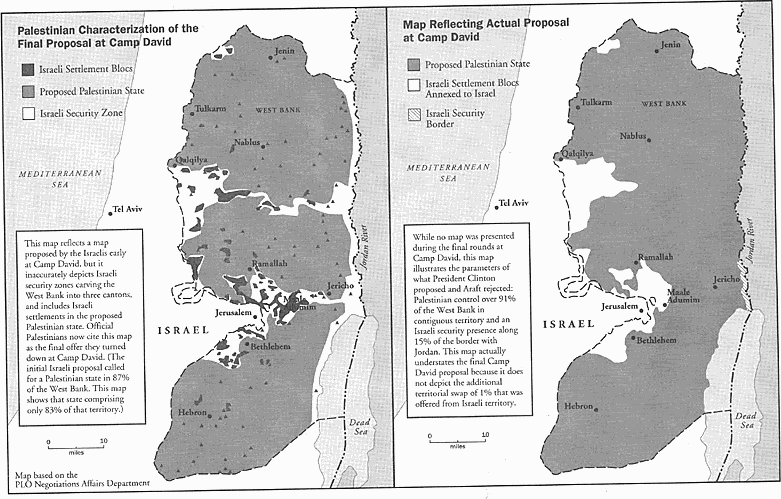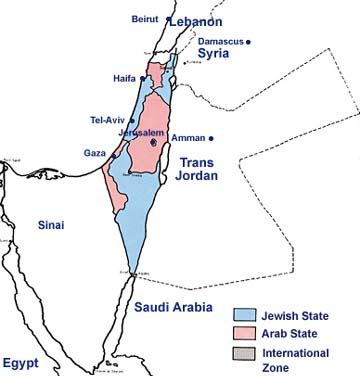The Palestinian leadership, both now and historically, also hold responsibility for the occupation. The reason for this is because they have never accepted any of the offers for statehood and were it not for that intransigence there would be no occupation today.
For example, in 1937 the British Peel Commission suggested partitioning Palestine, sans Trans-Jordan, into a Jewish state and a Palestinian Arab state. The Palestinian leadership rejected the proposal.
In 1947, of course, the United Nations enacted Resolution 181; another partition plan, accepted by the Jews and rejected by the Palestinians. It was 181, needless to say, that resulted in recognition of the state of Israel by the world body.
In 2000, during the Camp David Accords between Israeli PM, Ehud Barack, PLO President, Yasser Arafat, and US President, Bill Clinton, the Palestinian leadership was again offered a state and, yet again, they refused. Apologists for Palestinian intransigence on Daily Kos often claim that Barak's offer was not good enough. That it divided the WB into "cantons" that would have represented nothing so much as a "rump state."
This is false.
Dennis Ross was the chief US negotiator during the negotiation process and in his 2004 book, The Missing Peace: The Inside Story of the Fight for Middle East Peace, he includes the maps shown below.

The text next to the map on the left reads as follows:
This map reflects a map proposed by the Israelis early at Camp David, but it inaccurately depicts Israeli security zones carving the West Bank into three cantons, and includes Israeli settlements in the proposed Palestinian state. Official Palestinians now cite this map as the final offer they turned down at Camp David. (The initial Israeli proposal called for a Palestinian state in 87% of the West Bank. This map shows that state comprising only 83% of that territory.
The map on the right shows the actual offer. The text reads:
While no map was presented during the final rounds at Camp David, this map illustrates the parameters of what President Clinton proposed and Arafat rejected: Palestinian control over 91% of the West Bank in contiguous territory and an Israeli security presence along 15% of the border with Jordan. The map actually understates the final Camp David proposal because it does not depict the additional territorial swap of 1% that was offered from Israeli territory.
The map, of course, also does not show that along with 100% of Gaza, over 90% of the West Bank in contiguous territory, the Palestinians were also offered the Arab sections of East Jerusalem as the capital of the Palestinian state.
This is what Yasser Arafat rejected in 2000.
This next map shows the UN partition plan, under Resolution 181, in November of 1947:

The area in blue represents the proposed Jewish state, which the Jews of the Yishuv accepted. Notice anything unusual?
It is 3 clearly distinct and separate cantons! There is a small region in the north-east, a strip along the Mediterranean Sea between Haifa and Tel Aviv, and the Negev desert in the south.
The offer did not include Jerusalem.
Yet this is what the Jews accepted. This offer was, in fact, far worse than what the Palestinian leadership rejected in 2000. But the Jews accepted because they were determined to gain their independence, their autonomy, and to build a state for their nation. And they did so.
Yet here we are, lo these many decades later, and the Palestinian leadership, under Mahmoud Abbas, cannot even bring itself to negotiate the possibility of statehood, allegedly because of settlement construction within blocs that will end up part of Israel in any likely negotiated settlement, anyway.
Netanyahu has called for negotations and Abbas has rejected that call.
The Palestinian leadership continues to reject any possibility of a Palestinian state next to Israel. This is what they rejected in 1937, when offered by the British. It is what they rejected in 1947, when offered by the United Nations. It is what they rejected in 2000, when offered by the Israelis. And it is what they continue to reject.
If the Palestinian people want their freedom, they can have it. All that is required is that their leadership finally accept an offer of statehood. I very much hope that they will some day.
I am not optimistic, however.
Uh reality check. If they did that they might have to actually GOVERN. "Resistance," pays too well.
ReplyDeletedoodad,
ReplyDeleteyou might want to check out this article
http://www.hoover.org/publications/policyreview/41708942.html
The Power of Statelessness
By Jakub Grygiel
The withering appeal of governing
Cheers!